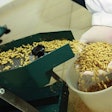The growth in fuel ethanol production has dramatically increased the production of distillers dried grains with solubles (DDGS), a granular bulk product obtained from the non-fermentable residues of corn during ethanol bioprocessing using the dry grind production process.
For every bushel of corn converted into ethanol — a third which constitutes the unfermentables — is dried and sold as DDGS. Since DDGS is primarily used as a feed ingredient for livestock diet rations (beef cattle, swine and poultry), most plants are set up to produce the dried coproducts. Once created, they are shipped via truck or rail for use by distant customers.
In the United States limits have been placed on the proportion of DDGS used in feeding livestock, constraining growth in the domestic market. Since there is no other major value-added use of DDGS in the United States, the growing overseas market, which commands a large supply of DDGS, is important. The export market makes long-distance DDGS transport to export markets important to the ethanol industry — especially as ethanol production increases to meet the Renewable Fuels Standard II (RFS2) mandate (15 billion gallons per year of corn ethanol).
Problems in DDGS transport
Flowability of DDGS has been cited as one of the major hurdles to expanding existing markets and developing new markets for DDGS. Two Class A carriers that were allowing DDGS transport in their cars no longer accept DDGS; and exporters in the Pacific Northwest refuse to handle DDGS because of flowability issues. Ethanol plants are left with the expensive option of leasing or purchasing their own hoppers — and owning or leasing railcars presents an unnecessary financial and logistical burden.
In order help with logistics, DDGS is normally transported in super jumbo hoppers, and is estimated to use about 70% of the available fleet in the rail industry. The use of freight containers have become a popular method of shipping DDGS, but they still encounter the same flowability issues as with hopper cars — affecting their availability and cost.
Given these obstacles, the improvement of DDGS logistics — especially its flowability from railcar hoppers, transport containers and feed bins — is important to growing the industry. Additionally, finding other value-added uses for this coproduct is also an important issue that must be tackled in order to grow the market for DDGS.
Transportation challenges with low bulk density
While flowability of DDGS is one of the major issues with product marketability, the low bulk density of DDGS has been a concern as well because less weight per given hopper volume can be achieved, which impacts shipping cost.
For example, a standard railcar with about 161.4 m3 (5700 ft3) volume will hold 62.8 metric tons of 389.3 kg/m3 DDGS compared to 80.9 metric tons of DDGS if the bulk density was up to 501.5 kg/m3. According to ASEA standards, corn with a bulk density of 720 kg/m3 will hold 116.2 metric tons of grain in the standard railcar; about 53.4 and 35.3 metric tons more than the low and high bulk density values. The higher the bulk density, the cheaper it is to transport DDGS, and expand its market. Because the bulk density of DDGS can vary from 389.3 to 501.5 kg/m3, the shipping cost for the product can be variable as well, and can even dictate how far a product is shipped and how well it handles.
Producing higher bulk density DDGS product, while meeting nutritional and handling requirements would have a huge impact on the cost of shipping this product.
In defense of pelleting
One of the options regarding ways to increase the bulk density of DDGS and improve its flowability is pelleting. Pelleting is a popular process used in the feed industry for blending and agglomerating feed ingredients in feed manufacturing. Added benefits include better product handling, palatability and flow. While pelleting is a favorable process for a lot of feed products, the high energy needed to extrude the feed material from the die, and die wearing can make it a cost prohibitive process. A recent study indicates that the cost of pelleting declined with production scale and pelleting DDGS is only feasible for larger plants (250 million gallon/year). This limits pelleting to a few large existing fuel ethanol plants in the United States. While there have been reported successes from research of pelleting DDGS, this practice might not be an economically feasible solution for tackling the logistics issue.
A recent invention at Purdue University entitled Biobased Carriers from Corn Co-Products and Methods for Production thereof (Provisional U.S. Patent 65095.P1.US) adds value to DDGS by producing spherical granules capable of carrying and dispersing biologically and chemically active molecules such as fertilizers, pesticides, and enzymes. Additionally, granulating DDGS increases the overall particle size and bulk density, thereby ultimately resolving the flowability and handling issues such as avoiding particle segregation which will reduce sampling error and improve product consistency.
This new invention was developed after preliminary studies were done producing DDGS granules (shown in Figure 1) using a lab-scale rotary drum dryer. DDGS granules manufactured in a granulating drum are spherical pellets with improved handling properties and increased bulk density compared with DDGS produced using the traditional blending and rotary drum drying process common in dry-grind ethanol processing. However, the basic feed material needed for granulating DDGS are similar to what is needed in the traditional process (Figure 2). The granulation process involves the mixing of WDG with CDS, and granulating the mixture using a rotary drum granulator. The granulating drum provides the mechanical force that enables solid particles of WDG to collide, densify and agglomerate (grow in size), while CDS acts as a binder gluing colliding particles together. The wet distillers grains with soluble granules produced are dried to obtain DDGS granules. Unlike pelleting, this method of granulation involves less energy and operating cost than pelleting, and thus is a good alternative to be considered for use.
Figure 3 shows four possible particle size ranges which were produced during our lab-scale experiments, compared with DDGS without granulation, also produced in our experiments. The granules produced were targeted in the size range of 1.7 to 3.4 mm. The bulk density of granulated DDGS in Group size II and III were higher than the ungranulated DDGS by 17 and 20 percent, respectively. It should be noted that bulk density of granulated DDGS will depend on the solids content of the feed and so a fundamental understanding of the feed (WDG and CDS) is essential to obtaining granules of the desired characteristics.
In comparison to other particles such as pharmaceutical powders, detergents, etc., granulating DDGS is not a trivial task and involves skill and good understanding of the fundamental science of granulation. This is because of the very heterogeneous nature of the feed material which is a combination of particles of germ, protein, fiber, residual sugars, and tipcap with varying physical structure and chemical properties. Our study was a first important step to understanding the process variables and granulation kinetics of DDGS granulation. While more work is still needed in understanding some of the fundamentals of granulating a complex feed material such as WDG and CDS blends, our study has progressed to the point where some pilot-scale work can begin.
Just add nitrogen: DDGS as fertilizer
In another parallel study, DDGS granules of a desired size characteristics was manufactured using nitrogen in the feed, with the attempt of producing a slow release fertilizer. In this study, DDGS was used as a carrier, while nitrogen was mixed within particles of DDGS and binder in one granule design and in a second granule design, nitrogen was used as the core, while DDGS and binder coated around the surface of the granule.
Our experiments were able to successfully granulate DDGS with the inclusion of nitrogen — thus proving its potential for use in a fertilizer matrix; however, the granules produced were not rated as slow release, and thus more work needs to be done in order to develop slow release fertilizers or other similar functions with DDGS. Two important granule characteristics that are important as fertilizer carriers are shown in Tables 2 and 3.
Table 2 shows the resistance to attrition, a measure of the granule ability to resist breakage during transport and handling was over 95% for the desired sizes, Group II and III. Some of the flowability indices measured such as the compressibility index (CI), Hausner ratio (HR) and angle of repose (AoR) indicate that the granules produced have good flow characteristics.
In summary, a process for granulating DDGS to produce spherical pellets have been successfully developed and promises to alleviate some of the logistical and handling issues facing DDGS marketing. Additionally, the DDGS granules have been shown to potentially have prospects as carriers in fertilizer application which could open up a new value added opportunity for DDGS. Work is still under way to scale-up the process so that it could be brought to commercial use. Exploring these opportunities with the industry will be key to their successful deployment.


















